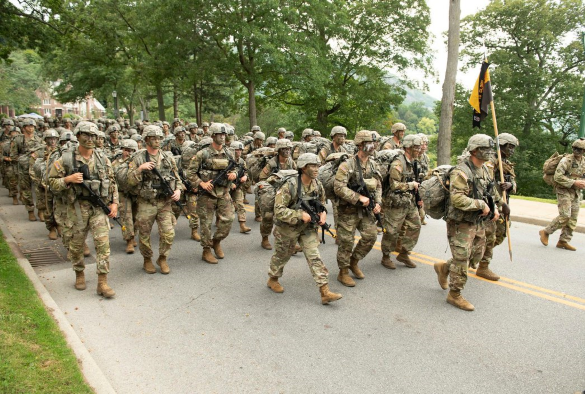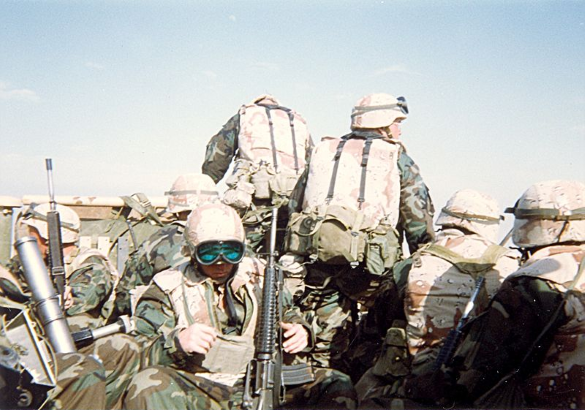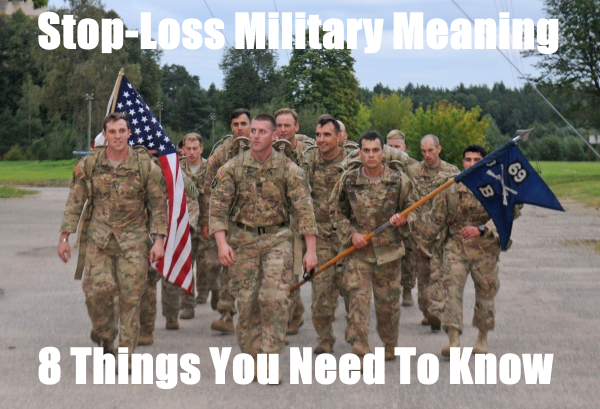When a new recruit joins any branch of the U.S. military, they sign and agree to a legally binding contract that stipulates the length of their service commitment.
Stop-loss is a policy that allows the military to involuntarily extend this service commitment and the service member is contractually obligated to fulfill their duty during the extension.
Military stop-loss orders can be applied to certain career fields to retain service members with valuable skills as well as specific military units to maintain personnel strength and continuity.
Here are 8 things to know about stop-loss in the military and what it means.
Related Article – Palace Chase Program: 8 Things You Need To Know
Table of Contents
1. What Does Stop-Loss Mean In The Military?

A stop-loss order in the military means that the term of active service is being involuntarily extended for some or all of current military personnel.
Each service member has an ETS (Estimated Time in Service) date that indicates the end of their legally binding commitment to military service.
If stop-loss is initiated, the ETS is extended beyond the original date by the military.
Therefore, if a soldier, sailor, airman, or Marine is due to separate from active service or retire in fulfillment of their active duty commitment, a stop-loss order would suspend their ETS date.
In that case, the service member would have to continue their active duty status until the military rescinded the stop-loss order.
2. What Are The Two Types Of Stop-Loss?
The military can use stop-loss in two ways:
- Based on career field: This type of stop-loss prevents critical skill loss in certain military career fields. Therefore, personnel with specific, integral skillsets are retained for military operations.
- Based on unit: This type of stop-loss ensures that certain military units do not lose essential members to preserve personnel strength. Unit-based stop-loss would likely apply to service members with ETS dates occurring during deployment, involuntarily extending their service.
These two types of stop-loss, therefore, typically only affect service members in specific career fields or units rather than the military or its branches as a whole.
Stop-loss orders can be authorized by the U.S. President.
The President can also delegate the authority to issue stop-loss orders to the service chiefs.
This would include the Secretaries of the Army, Navy, Air Force, etc.
Once a stop-loss order is issued, it is communicated to the affected troops.
Depending on the situation, troops may learn of stop-loss measures during briefings or messages from their chain of command.
Unit orderly rooms and command support staff are provided information regarding the order when it is issued.
Related Article – Army MOS List: A List Of All 159 Army Jobs
3. What Are The Effects Of Stop-Loss?
When implemented, stop-loss results in various effects for military service members and their families.
For example, a stop-loss order can impact PCS moves (Permanent Change of Station).
During stop-loss, certain military personnel and their dependents would have their move to another base or post suspended.
This would be to prevent staff shortages for certain critical missions and/or to maintain unit integrity for consistency in operations.
Stop-loss can also affect the length of time service members are away from home by extending deployments for 90 days.
In addition, military stop-loss can have dramatic effects on a service member’s plan to transition to the civilian sector by delaying retirement or separation from active duty.
However, as compensation for stop-loss orders, the current rule is that the military must pay affected service members $500 extra per month.
4. How Does Stop-Loss Differ From Mobilization Of Reserves?

When reservists or National Guard members are called to active duty, this is a different policy than stop-loss.
In general, any reservist in the military can be called to active duty upon declaration of war or national emergency.
What many civilians may not realize is that many service members remain “inactive” in the reserves after they leave active duty.
This is due to a contractual obligation which stipulates that the minimum length of service for those who join the military is eight years.
Four of those years are meant for active duty service.
The remaining four years are meant for service as part of the Individual Ready Reserve (IRR).
The IRR is not part of active or selective reserves.
Its purpose is to supplement active forces in times of emergency.
This means that IRR service members can be recalled for duty at any time during their four remaining years.
However, reserve policies are separate from any stop-loss orders.
5. Is Stop-Loss Legal In The Military?
Stop-loss is legal in the military, though it is a controversial policy among some groups.
For example, a significant number of activists along with some politicians have criticized and/or protested stop-loss procedures.
Some have termed the military’s stop-loss policy as a “back-door” draft, with concern that it undermines the trust of affected members of the Armed Forces.
In addition, stop-loss has been qualified by opponents as problematic as far as the military’s ability to recruit and retain service members for the long term.
However, by contractual agreement with individual service members, stop-loss orders can extend active duty commitment beyond the initial ETS date to which the service member commits.
It is this stipulation in the contract, agreed to by all military personnel upon joining the Armed Forces, that has led to stop-loss being legally upheld even when lawsuits have challenged the order.
The U.S. court system has found that extension of enlistment is allowed and legal due to the contractual agreement between the Department of Defense and those that commit to active service.
Related Article – Hometown Recruiter Assistance Program
6. When Has The Military Used Stop-Loss?
Records show that the military has used some form of stop-loss measures since the American Civil War.
In fact, there is legal evidence of a Union soldier’s challenge to the government for involuntarily extending his service beyond his three-month commitment.
Most sources agree that the modern practice of stop-loss originated during the Vietnam War era, though this phrase would not have been used to describe the order.
After the Vietnam War, the U.S. Congress developed stop-loss measures that applied to all branches of the Armed Forces.
In 1984, United States Code, Title 10, stipulated a policy that allows the Commander-In-Chief to suspend rules for military promotions, retirements, and separation during a national emergency.
This policy could also be put into effect when the President has called up reserve components.
Stop-loss, as legitimized by Title 10, was first used during the Gulf War of 1990 to 1991.
Initially, the policy applied to all deployed personnel.
Later, stop-loss applied to selected service members with critical skills.
Stop-loss was also in effect during developments in Bosnia and Kosovo in the late-1990s.
In 2009, Public Law 110-329, “Consolidated Security, Disaster Assistance, and Continuing Appropriations Act” further systemized the policy of stop-loss.
However, facing backlash for stop-loss measures led to restraint by the U.S. Armed Forces in pursuing this policy.
Instances Of Stop-Loss Orders By The U.S. Military

Here are the instances in which stop-loss orders were given during contemporary military operations:
- Persian Gulf War
- Somalia
- Haiti
- Bosnia
- Kosovo
- After the attacks on 9/11
- Global War on Terror
Across the final months of 2009, the Army ended stop-loss for troops on active duty as well as in the Reserves and National Guard.
In 2009, Defense Secretary Robert Gates announced a policy that would maintain the authorization of stop-loss measures, yet would effectively end stop-loss practices.
7. What Is The Current Outlook For Military Stop-Loss Orders?
At this time, there is no public information regarding any military stop-loss orders.
However, it is possible that the Department of Defense (DoD) would consider a stop-loss order at any time if it were deemed necessary.
For example, current or future pandemic conditions could conceivably present a problem in maintaining troops.
Yet it’s important to note that DoD officials try to avoid stop-loss orders if possible.
These measures are structured on an individual case basis to ensure mission requirements are met and operations are secure.
Stop-loss orders are possible and can be activated at any time and at the government’s discretion.
In most cases, stop-loss measures require a declaration of an act of war or national emergency by Congress.
If Congress is out of session, the President can declare a national emergency if this is considered in the nation’s best interest.
This means that all military members on active duty can be retained for at least six months.
Congress may become involved to reverse or change this stop-loss decision.
Overall, these procedures are not intended to be arbitrarily applied to military career fields or units.
8. Alternatives To Stop-Loss For The Military
It’s in the Armed Forces’ better interests to find alternatives to stop-loss orders.
This means finding ways of incentivizing voluntary recruitment and retention of forces.
One alternative to stop-loss is extending contracts for some members within the service branches.
Here are other alternatives to stop-loss being utilized by each military branch:
- Army: offering voluntary reenlistment contracts for the short-term, with extension options available for 3 to 11 months.
- Marine Corps: offering voluntary service extensions for Marines with upcoming separation or retirement dates.
- Air Force: shortened basic military training program and enhancing preventive pandemic measures.
- Navy: offering extended service contracts for current sailors and inviting recently separated sailors to return to service.
If a service member is eligible and voluntarily extends their service contract, they can receive special assignment incentive pay.
This pay varies depending on location, specialties, and branch limitations.
However, incentive pay can reach as high as $1500 per month.
Department of Defense officials assert that stop-loss is only ordered if absolutely necessary and it’s a measure that the military works to avoid if possible.
In most cases, only a select few service members would be affected by stop-loss.
This would be dependent on the demand for critical skills or to maintain unit cohesion.
Ultimately, the military’s goal is to consider a range of options to ensure national security mission readiness and capability.
- Ikon Pass Military Discount: Learn How To Save Big - January 31, 2025
- RTIC Military Discount: Find Out How To Save Big on Gear - January 30, 2025
- Traeger Military Discount: Learn How To Save Big on Smokers - January 28, 2025





